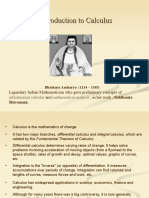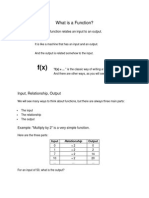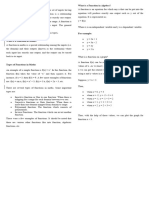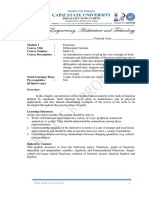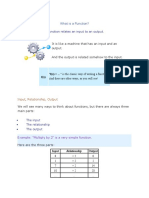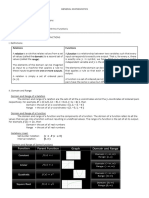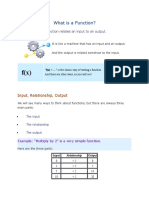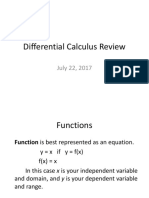0 ratings0% found this document useful (0 votes)
40 views15 pagesOptimization Chapter 1 Functions
Optimization in economics
Uploaded by
gk3335000Copyright
© © All Rights Reserved
We take content rights seriously. If you suspect this is your content, claim it here.
Available Formats
Download as PDF or read online on Scribd
0 ratings0% found this document useful (0 votes)
40 views15 pagesOptimization Chapter 1 Functions
Optimization in economics
Uploaded by
gk3335000Copyright
© © All Rights Reserved
We take content rights seriously. If you suspect this is your content, claim it here.
Available Formats
Download as PDF or read online on Scribd
You are on page 1/ 15
3-2 INTRODUCTORY MATHEMATICS FOR BUSINESS ayy £0,
Mig,
3:1, INTRODUCTION a
jsion problems which use mathematical tools, the first require,
Lents Sonny define all significant interactions or reletlonshipg ammongert 4
factors (also called variables) relevant to the problem. These relationships ysga™)
stated in the form of an equation (or set of equations) or inequations. Such ¢, mat
simplified mathematical relationships help the decision-maker in understand
complex management problems. For example, the decision-maker knows that emg!
of an item is not only related to price of that item but also to the price gp
substitutes. Thus if he can define specific mathematical relationship (alg 04"
model) that exists, then the demand of the item in the near future can be forecsses
The main objective ofthis chapter isto study mathematical relationships (or funn
in the context of managerial problems. )
3-2. FUNCTIONS
A function is a technical term used to symbolise relationship between variable,
When two variables are so related, that for any arbitrarily assigned value to one o
them, there corresponds a definite value (or a set of definite values) for the other, he
second variable is said to be the function of the first.
For example, the distance covered is a function of time and speed. The railway
freight charged is a function of weight or volume, the quantity demanded or supplied
is a function of price, etc. The area of a circle depends upon the length of its radius
and so the area is said to be the function of radius.
Thus, a function explains the nature of correspondence between variables
indicated by some formula, graph or a mathematical equation. We can say that 2
function is some sort of a mould which gives some unique shape to the materia
poured into it. It should be remembered that it is not the degree of variation but the
way the variables move in a given function which is of significance. However, a
functional relationship should not be confused with any casual (cause and effect)
relationship. It is purely a mathematical relationship.
The idea of function is sometimes expressed as :
The relationship between two real variables say x and y which are so related
that corresponding to every value ‘a’ of x defined as the domain, we get a finite
value ’b’ of y defined as the range, then y is said to be the function of x.
The fact that y is a function of a variable x is expressed symbolically bY
equations : ¥=F(2),y=F (x), y= 9 (2), etc.
The set of the values of x belonging to the domain of a function generate anol
set which consists of values of y (or f (x)). This generated set is called the range ©
function f(x). If¢ is any particular value of x, the value of function f(x) for *=
denoted by f (c)
: a
If the relation between x and y is such that the value of y is fixed as 500" #1
definite value is assigned to x then the variable y is said to be dependent variable a
apeal at
is the independent variable. The independent variable is sometimes called the arg”
of the function.
cis
© scanned with OKEN Scanner
ictiONS 43
now clarify the ct
n y the above concept of function by the following, examples
always equal tox, then y is a function of x and we writ
yar Ties
similarly ¢ log x, (x +a)", etc., are functions of x. roa
fi) Ifyis defined by saying that
f =x, whenx>2
y =x-1, whenx<2
weshal
ity
ere y is defined as a function of x but two form: i
i wulae have been used to define the
function, one holds for one part of the domain and the other for the remaining part of
the domain.
(ii) Consider the two numbers x and y with their relationship defined by the
equations :
y =, whenx <0
y =x,when01
‘The domain of definition ofthis function which is expressed by three formulas is
the whole set of real numbers. The first formula is used for the domain of all real
ne, less than 0. The second formula is used for the domain of all seal numbers
numbe
lying between O and 1. The third formula is used for the domain of all those real
rumbers which are greater than 1.
(jo) Let ye!
Here y is function of x defined for aggr
33. NOTATIONS FOR FUNCTIONS
‘The mere fact that a quantity is a function ofa single variable, say %, is indicated
by writing the function in one of the forms F (0), F DW (0-8 Ce one fa fa Ce oon IE
coon these occurs alone, it is read “a function of x” or "some function of x” ; if some of
these are together, they are read “the ffurction of x", “the F-function of x", “the phi-
function of x, .. The letter y is often used to denote a function of x.
‘The fact that a quantity is a function of several variables, x, y, is indicated by
means of several symbols, f (x; 9), 4 (% Wy FQ, Yr 2) YY 2 .) These are read as
“the function of x and y”, “the phi-function of ‘and y’, “the F-function of x, y and 2,”
etc.
‘egate of positive integers only.
Sometimes the exact relation between the function and the dependent variable (or
Variables) is stated, as for example :
fQ)=at+3x-7, oF yeasty Ba -7, F(t y= 2 +70 + yk
In such cases the f-function of any other number is obtained by substituting that
number for x in f (2), and the F-function of any 'wo numbers is obtained by
Substituting those for x and y respectively in F (x y). Thus.
f@ a 43z-7, f(A) a8 3 x4-7 = 21
fl.2) =2e + 7e +b 1 F (2,3) = 32 +768 +5
© scanned with OKEN Scanner
34 INTRODUCTORY MATHEMATICS FOR BUSINESS AND goo).
Mi
( Constants. The symbols which retain the same value throughout a set of mary,
operations are called constants,
It has become customary to use initial alphabets a, , c, ...
constants. These are of two types:
(a) Absolute constants. Those which have the same value in all operatio,
Matic
88 Symbols 4,
8 ang
discussions. For example, 1, V2, ¢ are absolute constants.
() Arbitrary constants. Those which may have any assigned value throughout
of mathematical operations.
For example, the radius of a circle or the sides of a right-angled triangle jn
forming the trigonometric ratios are the arbitrary constants.
(ii) Variables. Ifa symbol x denotes any element of a given set of numbers, then y
is said to be a variable. The last few alphabets x, y, z or u, Ut, ... are generally used tg
denote variables.
The variables which can take an arbitrarily assigned value are usually termed a5
independent variables. The other variables whose values must be determined in order
that they may correspond to these assigned values are usually termed as dependent
variables. It will be seen later that a “function” and “dependent variable” are synonymous
terms.
set
(ii) A Continuous Real Variable, If x assumes successively every numerical value
of an aggregate of all real numbers from a given number ‘a’ to another given number
‘8, then xis called a continuous real variable.
(iv) An Interval. Ifa variable x which can take only those numerical values which
lie between two given numbers a and b then all the numerical values between a and b
taken collectively is called domain or interval of the variable x and is usually denoted
by (a,b).
If the set of values say x is such that @ $x 0 or a <0. Each parabola has a vertical axis of
symmetry and a turning point called a vertex. It can be shown that the x-coordinate
the vertex of a parabola opening upward or downward is given by -b/22. The J.
coordinate of the vertex is then f(-b/2a), Its vertex (x, y) (which is the lowest pol"
when a > O-and highest point when a <0 is at the point, x =- 2» y = S=- Alo
(i) the vertex is the minimum point when a > 0 (in this case the graph opens upwards)
(@)is a maximum point when a <0 (inthis case the graph opens downwards).
V. Step Function. For different values of an independent variable x in an inter
the dependent variable y = f (x) takes a constant value, but takes different values
© scanned with OKEN Scanner
yr
Ancrions 3-7
aiterent intervals. In such cases the given function y =f (x) is called a step function,
ge
Yu if 0 0) is an exponential function, where a is the base and x is a real number
exponent.
some Characteristics of Exponential Function :
1. An exponential function y = a* is defined for only the positive values of a (i.¢.,
fora > 0) and a* is always positive,
2. Ifx>z and a > 1,a* > a®, In other words, for a > 1 the function y = a* is an
increasing function of x.
3, If0< a<1and x > z, we get a* Oand a #1, we find that y = a* is a continuous function with domain
being real and range (0, ~).
5, Ifa=1,a*= 1. Thus, for a = 1, the function y = a* becomes a constant function.
6. The graphs of a and 3=0~ are the reflections of each other about the y-axis.
Vil. Logarithmic Function. A logarithmic function is expressed as_y = log, x,
wherea #1 and x > Ois the base. It is read asy’ is the logarithm to the base a of x. This
canalso be written as x= a.
Thus from an exponential function y =a, we may construct the logarithmic
function x = a¥ by interchanging the variables. This shows that the inverse of an
exponential function is a logarithmic function.
‘The two most widely used bases for logarithms are 10 and e (= 2:7182).
(), Common logarithm. It is the logarithm to the base 10 of a number x and is
written as logyo%. If y = logyo x, then x = 10%.
(i) Natural logarithm. It is the logarithm to the base e of a number x and is
usually written as log, x or In x.
Remark. When no base is mentioned, it will be understood that the base is 10.
Some important properties of the logarithmic function y = log, x are as follows :
() log 1 =0 (if) log e = 1 (ii) log (xy) = log x + log y (Fv) log (x/y) = log x-log y
©) log (x") =n log x (vi) loge 10=jogce (vii) log. a = (log. 10) (logia a) = oe
(iit) logarithm of zero and negative number is not defined.
© scanned with OKEN Scanner
nTRODUCTORY MATHEMATICS FOR BUSINESS AND go),
‘On
3:8
tions :
of. Logarithmic Fune'
fined only for the positive
xisde value
inverse of a continuous function,”
eo] and R respectively,
Some Characteristics oF ™* ;
A Togatithmie function Y= logs
sa continuous function being the
‘ 2 log, x are [0,
1
2
F The domain and range of!
of all real numbers. ;
Jogarithmic function ¥ =
nction y = log,
Rbeing 4,
we
Ifa>1, the log, x increases slowly.
a>1,the
ito 0) decreases slowly,
tog (#) = 3 for every real val " a
Trarbase a ofthe logy xis always taken asa non-zero positive number,
Logarithm of zero or a negative number is not defined for any base,
Jog, a= 1, te, logarithm of a number with respect to its own base is alyy,
: /s
unity.
10, The curve representing y = log,» lies entirely in the first and fourth quadran,
11. The curve of y = loge x, (@ # 1, > 0) is asymptotic to the y-axis and has y
intercept (1, 0)-
12, The parameter ‘a
ae
jue of x.
Cerne
/ determines the curvature of the function y = log, x.
Exponential
function me
fe Logarithmic
function
y= log, x (a> 1)
orx= ay
7
Fig. 3:1.
L vill. Rational and Irrational Functions. Expressions involving x whi
a finite number of terms of the form ax", in which a is constant and 1 PS
integer, ¢.g., 4x4 + 3x3 - 2x + 9x —7 is called a rational integral function of x.
If an expression in x, in which x has positive integral exponents only and @ i
calle
number of terms including the division by a rational integral function of x itis
a rational function of x,e.g,, ats, eae, Tee
fe wy ete.
jich consist of
sitive
Remark. Rati Li ; . ; |
in ra itar tk Rational integral functions and rational fractional functions are generlY inl
‘An expression involvi {ies |
pression involving x which involves root extraction of term is called
irrational function, e.g., Vx, Vx? + 4x +5, VOx=7.
© scanned with OKEN Scanner
or!0Ns 39
Moro eat on {When the dependent variable increases with an
the independent varia le, the function is called a monotonically inereasing,
tions FOr cxamp! le, 7 junction of supply is a monotonically increasing function of
rice AS against this a demand function is a monotonically decreasing function of
ees pecause the quantity demanded decreases with increase in price. A function y=
fs jcalled a monotone increasing function in an interval if a larger value of % gives a
Aor vale of yi an increase in x causes an increase in yin an ‘interval. Similarly, 2
8" on is called a monotone decreasing function in an interval if an increase in the
of x always brings out a decrease in the value of the function in that interval.
and x, are only two numbers in the interval such that x2 > 1, then
fz) is monotonically increasing if f(x) > fli)
fix) is monotonically decreasing if f(x,) 0.
ase in
i
value
us if
The graph of a demand functior
eh line whose slope is negative,
so, since negative price and negative quantities are meanin,
suptutther, if p denotes the price per unit and x denotes the corresponding quantity
‘upplied of a certain product, then we can write the supply function as +
x= 6(p), showing the dependence of p on x
or p=y(a), showing the dependence of x on p.
© scanned with OKEN Scanner
3-10 INTRODUCTORY MATHEMATICS FOR BUSINESS ayy FON
MH
ion is called a supply curve which is usualy
The graph of a supply function is called a supp i Yat
line with positive slope, ‘e,, supply function is an increasing function, and both vat
Xare non-negative, ’ ;
2. Cost Function. Let C be the total cost incurred in the production of y Units
commodity. Then, a function relating C and x is called a cost function and
generally written as: = C(x). :
Its graph is called cost curve. The cost function consists of two Parts :
(i) Fixed Cost denoted by F (x) whichis the sum of all the costs that are indep.
level of production, namely, rent, insurance, depreciation and other overhead exp
en loans and upkeep of the establishment which exist even while there is no prod
{i} Variable Cost denoted by V(x) is the sum of all cost that are de
Production, namely, cost of material, labour, cost of publicity, fuel et
number of units (x) produced,
Thus the total cost function is given by: C(x) = V(x) + F(x).
ofa
it ig
endent oft
enses, interes,
luction,
Pendent on the level o
fc. It depends upon the
Remark. Cost curves are generally increasing curves (i, they rise from the left tothe right
as the cost of production usually increases with the output (2).
Average cost of production or cost
Per unit is obtained by dividing total cost by
the quantity produced, ie., A(x) = C/x,
quantity of the commodity that is actually sold,
firm at price p, then the total revenue (R) colle:
R@=px P=R(x)/x
‘Thus the price p is also average revenue of the firm,
4, Profit Function. The revenue and cost function
firm, as the profit is the excess of revenue ove
function of the firm takes the form : P(x) = R(x) —C(s), where R(x) is the total revenue
(income) received by selling x units and C(x) i
Production of x units of a product.
5. Overall Consumption Function. If
community dependent on income Y and proj
consumption function is indicated by C =a +cY.
C is the total
, consumption of the
Pensity to cons,
ume c, the aggregate
Butsince Y=C+S,5=Y~(a+c¥) is the savings function of the co; it
Example 3-2. (a) Suppose there is demand of 60 units of a produet Beeeded
Re, 18 per unit and 40 units whe its price is Re 28 ech fe fhe ape spree
assuming that itis linear, lemand function,
(b) When the unit price ofan item is Rs. 5, the daily
increased to Rs, 10, the daily supply is found to be 200
that it is linear,
Solution. (2) Let the demand function be p = a + by,
where p, in rupees is the price per unit and x is the number of units oo)
demanded. Of the product
When x = 60, p = 18 and when x = 4, p = 28,
supply voi
Ped 26 100. When the price is
“PPly function, assuming
© scanned with OKEN Scanner
yr
f
| gor 8 3-11
pututing these values of x and in (+), we got 16 =a + 604,28 = a-+40b.
saving these equations, We obtain a= -1/2 and b= 48, ‘
sghe required demand function is: p= 43-1 x
. ae
eetie supply function be: pectdx “
\ ber of items available and ing pri 7
jgre vis the num ind p is the corresponding price.
w en p=5,x= 100 and when p=10,x=200. :
substituting these values in (*), we get 5=c+100d,10=c+200d
saving these equations, we obtain c=0,d=2.
__ The required supply function is: p =e
example 3-3. A company manufactures chocolate powder tins and the cost of
ature ofeach tin is Rs. 18 plus a fixed daily overhead cost of Rs. 900 It sells each tin at
ps.20. Determine the profit function. What is the profit if 1,000 tins are manufactured and
Eitaday ? How do you interpret the situation ifthe company manufactures and sells 200 tins
y? : .
‘solution. Let x tins be manufactured and sold each day . Now
Total cost = Fixed cost + Variable cost => C (x) = 900 + 15x
Revenue function is given by :
R(x) = Sale price per tin x Number of tins sold = 20x
Profit function is given by :
P(x) = R (x)- C(x) = 20x- (15x + 900) = 5x - 900
Substituting x = 200 in (*), we get (200) = 5 x 200-900 = 100.
“. The company earns a profit of Rs. 100 per day by producing and selling 200
Example 3-4. A man producing very fine earthenware lampstands found that he could
«dll onan average of 4 stands per day at a price of Rs. 18 each. When he increased his output to
average of 45 per day he could only obtain Rs. 17:5 each, ifhe were to sell all his output.
‘Assume that he maintains no inventories, so that he sells all he produces, and that the
‘propriate demand function is linear and is of the form : x =a + bp, where a and b are
canstants, x isthe average number sold per day and p is the price. An accurate survey into his
ltl daity production costs produced the relationship : C(x) = x2 ~ }x + 54 between the
{ola production cost, C, and the average daily production, x.
() Determine the demand function giving the average number sold per day, x in terms
ofthe price, p.
(i) Find an expression for the gross profit per day in terms of the average number of
Stands produced and sold.
(ii) Find the profit when 6 stands are produced and sold.
Solution, (i) Demand function: x =a + bp
When price, p = Rs.18, demand, x = 4 per day on average, 4=a + 18b
When p = Rs, 175, demand = 45 per day onan average, 45=a+175b
Solving (*) and (*), we obtain a=22,b=-1.
The demand function is : x = 22-p and revenue function, R(x) = (22-2) x
© scanned with OKEN Scanner
FORY MATHEMATICS FOR BUSINE,
312 IntRoDUCT 88. AND kg
NOY
1 5) Ue era
i) Profit function: P(x) =x (22-4) = (5 a? = 5x +54) =~ 1.542 25454
ii) Gross profit when 6 stands are produced and sold
3x (62+ 2x 6-54 = Rs. 27,
Example 3-5. Assume that for a closed economy, E=C +1 + G, where Ej
: ” : ; i
expenditure, Cis expenditure on consumption goods, lis expenditure on investment yl
G is government spending. For equilibrium, we must have E = Y, where ¥ is tye) incon
received.
Fora certain economy, it is given that C = 15 + 0-9Y, I= 20 +005Y, and G=
equilibrium values of Y, C and I. How will these change if there is no government s
Solution, Here we are given that E =C+1+G
and for equilibrium E =
From (1) and (2), we get Y =C+I+G
Substituting the given values of C, Iand G in (3), we obtain
Y =(15+09Y)+ (20 +0.05Y) +25 = 60 +0.95Y
= ¥1-095) =60 or y = =1,200
25. Fing the
Pending 7
Now C =15+09Y =15+09x 1,200 1,095
and 1 =20+0.05Y = 20 + 0-05 x 1,200 = 80
The required equilibrium values are given by (4), (5) and (6). If there is no
Sovernment spending then G = 0 and the equilibrium equation takes the form
Y =C+I=(15 +09Y) + (20+.0.05Y) = 35 + 0.95Y
6)
(6)
aU)
= ¥Q-095)=35 or y= 35-709 8)
Now C =15+09Y =15+0-9x700 645 (9)
and 1 =20+005Y =2040.05x700 =55 (10)
The changed values of Y, C and I, if there is NO government spending, are
respectively given by (8), (9) and (10). pending,
Example 3:6. The manager of a real estate firm faces the roblem of determining the
monthly rental for each of the 60 newly built apartment units, At a reat of Bs, 800 per
month, all apartment units will be occupied. But one apartment Unit is likely to remain vacant
for each Rs. 20 increase in rent. Also, an occupied a ret
partment requir er month
thant a vacant one for service and maintenance eauires Rs. 80 more per mon
Find the function which expresses the relationship bergen en
if r of
unoccupied apartment units, S1O85 profit and number of
Solution, Let x represent the number of vacant apartment uy
er occupied apartment is (800 + 20x), number of cera
end the extra operational cost for all the occupied apartment us is 80 (60
Since rental times the occupied apartment minus operational 4). |
profit, the gross profit function P(x) is: cost equals gros
P(x) = (800 + 202) (60x) ~80 (60-2) = _ a0,
inits. Then the rental
+ 480x + 43 200,
© scanned with OKEN Scanner
yr
rons 313
prEAK-EVEN ANALYSIS.
36 he profit function, P
call that the p unction, P(a), from producing, “otle aiiel del ;
ea en ees
: ci PQ) = R(x) - CQ).
qhere are three distinct possibilities in business :
Revenue earned by a business firm is more th is i,
ye tah te han the total cost incurred, i.
’ ne ont (x). In this case, P(x) = R(x) - C(x) > 0 and the business firm is
Revenue earned by the firm is less than the total i i.
i b cost incurred, ie., when
Ree) ‘< C(x). In this case, P(x) = R(x) - C(x) < 0 and the firm is running at 2
loss.
Revenue earned by the firm is equal to the total cost incurred, i. when
R(x) = (a). In this case P(x) = R (x) C(x) =0. net
‘Thus the firm is neither earning profit nor loss.
@
(i)
his isa special case of interest in business and economics. Such a situation i
ed business break-even. The value of x (ie, volume of production or the number of
Gite produced) when P(x) = 0, ie, when R(x) = C(x) is called the brenk-even point.
Break-even point
— Cost and Revenue
Fixed cost
‘Sales volume at B.E.P. X
Fig. 32: Graphical representation of Break-eoen point
Example 3-7. A company decides to set up @ small production plant for manufacturing
éketronic clocks. The total cost for inital set-up (fixed Cost) is Rs. 9 lakhs. The additional cost
(ce, variable cost) for producing each clock is Rs. 300. Each lock is sold at Rs. 750. During
‘he frst month, 1,500 clocks are produced anc sold +
(i) Determine the cost function C (x) for thetotal cost of producing x clocks.
(ii) Determine the revenue function R(x). for the total revenue, from the sale of x clocks.
(i) Determine the profit function P(x) for the profit fom the sale of x clocks.
— Volume
© scanned with OKEN Scanner
3.14 INTRODUCTORY MATHEMATICS FOR BUSINESS yp Fe
oy
(iv) What profit or loss the company incurs during the first month whey all y
he
clocks are sold ? Ly
omy
(®) Determine the break-even point. ’
Solution. (i) We know that cost function includes fixed cost and vay
From the given data, fixed cost = Rs. 9,00,000 and variable cost = Rs. 300 pe
C(x) denote the cost function to manufacture x clocks, then
C(a) = Fixed cost + Variable cost to produce x clocks = 9,00,000 + 30g,
Gi) Revenue function is calculated from the sale price. From the data, we op
that each clock is sold for Rs. 750. Hence if R(x) denotes the reventie from the
clocks, then R(x) =750x x =750x
(iii) Profit function = R(x) ~ C(x)
= 750x — (9,00,000 + 300x) = 450x ~9,00,000.
(fo) When 1,500 clocks are sold, profit is given by :
P (1,500) = 450 x 1,500 ~ 9,00,000 =~ Rs. 2,25,000
This shows that there isa loss of Rs. 2,25,000 when only 1,500 clocks are sold,
(0) At the break-even point, R(x) = C(x), is
9,00,000+300x=750x =» 450x=9,00,000 -. x=2,000
Hence to achieve break-even point, 2,000 clocks have to be sold.
able cy
cock
ere
of
Example 3-8. An automobile spare part manufacturing company introduces production
bonus to the employees that increases the cost of the spare part. The daily cost of production ¢
‘for x number of spare parts is C(x) = 2-05x + 550.
(@® If each spare part is sold for Rs. 3, determine the minimum number that must be
produced and sold daily to ensure no loss.
(i) If the selling price is increased by 30 paise per piece, what would be the break-even
point ?
(ii) If itis known that at least 500 parts can be sold daily, what price the company should
charge per piece of spare part to guarantee no loss ?
Solution. (i) The total revenue from sales is given by: R(x) = Rs. 3x
For the break-even point, we have CQa) = R@)
ao = 578-95
Thus at least 579 parts must be produced daily to ensure no loss.
(A) In this case, the total revenue from sales is given by : R(x) = Rs. 330x
For the break-even point, we have
3x=205x+550 => (3-205)x=550 or x=
550
3:30x=2.05x+550 = (3:30-205)x=550 or x = 440
With the increased selling price, the break-even point is 440 units.
(ii) If at least 500 spare parts can be sold daily, the price p per unit of spare P**
needed to ensure no loss is given by
500 p =205%500+550=1575 => p= —y=Rs. 315.
ing te
Example 3-9. XYZ Company is ready for the production of steam presses. During, el
first year, the costs for setting up the new production line are Rs. 3,00,000. These ar?
© scanned with OKEN Scanner
INS
anor : 3-15
additional cost of producing a steam pn 7”
emis eribl cost The compeny expel This cost is directly related to
IY expects the revenue from the sales of the steamt
11 ieee ooo per press. Assuming
fs ye Re eres omen nee Produced steam presses may be sold, find the
er Xo te to ¢ compart ill bre / 1 7 4
fe (i He comm wl fer as, ad enya a (ii) the company will
ol ol jution. The total revenue from sales of x steam presses is: R (x) = 270x
se fixed and the variable costs are given by F (x) = 3,00,000 and V(x) = 70x,
Ne cost function i given by: C\x) = Fla) + V(3) = (00,000 + 70x :
{p For the breakeven point: Cla) = R (2, ie,
300,000 70x=270x => (270~70)x=3,00000 «. x= 2 %g-°= 1,500
{iy To make profit, x must be more than 1500, ie, > 1,500.
{ip Obviously, the company would suffer alossifxis less than 1500, ie, x < 1,500.
(ao) The profit function is given by :
P(x) = R(x) - Cx) = 270x = (3,00,000 + 70x) = 200x — 3,00,000.
(Assorted REVIEW PROBLEMS FOR SELF-ASSESSMENT
inning production of a new variety of shoes. For the first year
she fred costs for setting up the new production line are Rs. 125 lakhs, Variable cost for
dosing each pair of shoes is Rs. 35. The sales department projects that 1,500 pairs can besold
pe first year atthe rate of Rs. 160 per par.
{Determine the cost function C(x fr the total cst of producing x pars of shoes.
(i) Determine the revenue function R() forthe total revenue from the sale of x pairs
of shoes.
(ii) Determine
(jo) 11,300 pairs are actually sold, what pro!
(0) Determine the break-even point.
4. A text book publisher finds that the production costs directly attributable 9 each book
are Ra a0 nd that ghe fixed costs are Rs, 10,000 If each book can be sold for Rs. 30, determine
thecost function, revenue function, and the break-even point
4. A.company sells its product for Rs. 4 per unit. Fixed costs for the company are Rs. 2,800
and varable costs are estimated to run 30% of total revenue, Determine
() the total revenue function, (fi) the total cost function, (ii)
and
(jo) the quantity the company must
5. The cost of producing x items is given
4, A shoe manufacturer is plat
the profit function P(x) for the profit from the sale ofx pairs of shoes.
fit or loss the company incur ?
) the break-even point,
sell to cover its fixed cost.
by C(x) = 2:80x + 600 and each item sells for Rs. 4.
() Find the break-even point.
(i) If itis known that at least 450 units will be sold, what should be the price charged
for each item to guarantee no loss ?
models :
6.Find the equilibrium prices and quantities for the two commodity market r
wh %q =-2-p +4 Xn xp e3-P tna tPA
7 here p is price and q is quantity. ;
(a) Explain : () Demand function and supply function, (iy Macket ecplbc rocal
pri 1 SUPP “constant and partly varies as the reciprocal
price p of a certain commodity is partly pally varie Oe ang The
fthe quanti
deh quantity demanded d. The supply function is $= * Bp, where a. and P at
and supply curves are] tue une re same graph taking the quantity on *-axis and
© scanned with OKEN Scanner
3-16 INTRODUCTORY MATHEMATICS FOR BUSINESS yp
price on y-axis. The equilibrium profit is (4, 6) and at price 5 units, the quantity
the quantity supplied are 5 and 3 units respectively. Determine the demand stl ang
funetions and find the price when (i) the quantity demanded is 8 units, and (jy ye’ "py
supplied is 13 units. Quant
8. Explain what you understand by Demand and Supply function and Mar
The demand law of commodity is p = mx + n. If the price is one unit, th
units and if the demand is 16 units, the total revenue is 144 units. Find the con:
p=2units, what is the total revenue ?
9. A computer software manufacturer wants to statt the production of floppy dig
observe that he will have to spend Rs, 2lakhs forthe technical know-how. The cos of sets
the machine is Rs. 88,000 and the cost of producing each unit is Rs. 30, He can sell ech floppy?
Rs.45. Determine () the total cost function for producing x floppies, and (i) the breakeya
point.
10. A company is ready for the production of an electronic medical
costs for setting up the machinery is Rs, 10 lakhs. Every instrument requi
of Rs. 250 which is called the variable cost. The company proposes to ma
an attractive price of Rs. 500. Before going to the market, the product s!
quality test in which the producer expects a 90% success. Find number
the company will () break even, and (ii) make profit.
deman,
Ket equi
we demand
stants
bri
sig)
Mandy,
instrument. The fixeg
res an additional og
rket the instrument at
should go through the
of products for which
11. A company is ready for production of medical instrument. The fixed cost of setting w
the machinery is Rs. 1,00,000. Every instrument requires an additional cost of Rs. 250
Produce. The company proposes to market the instrument at an attractive price of Rs. 500
Before going to the market, the product should go through the quality test in which the
producers expect a 90 percent suecess rate. Find
(#) the number of products for which the company will break-even,
(ii) the number of products for which company will make a profit of Rs. 10,000.
HINTS AND ANSWERS
1. (1,285,000 + 35x, (i) 160x, (fi) 125x ~ 1,25,000, (iv) Profit of Rs. 62,500, (v) 1,000.
2. (@ Weare given FC = 9,00,000 and VC = 300x.
“Total cost function, C (x) = 9,00,000 + 300x
(i) Total revenue function, R (x)~ C (x) = px = 750x.
(Gi) Profit function, P(x) = R (x) = 750x —9,00,000 - 300 = 450x - 9,00,000
() Profit when x = 1,500, is given as:
P (1,500) = 450 x 1,500 ~ 9,00,000 = 6,75,000 ~ 9,00,000 =~ 2,25,000
Note that profit is negative. Thus the company incurs a loss of Rs. 2,25,000.
3. (CC) = 10,000 + 20x, (ii) R (x) = 30x, (fi) 1,000.
4. (R(x) = 4x, (ii) C(x) = 2,800 + 1.24, (ii) x = 1,000, (iv) x = 700.
5. (0500, (i) Rs. 413 6.p=6,q=3, — 7.p (80+4p)-15(80-+4p)-240=0 = p=4
8
9
P=6)q=3 T.m=3+n = total revenue = 171-13 units when p =2 units
1. C(x) = 2,88,000 + 30x ; 19,200. 7
10. Hint. (i) C(x) = F (x) + V(x). It is given that F(x) = 10,00,000 ; V(x) = 250x_an¢
R(x) = 09 xx500. Hence solving for x from C(x) = R(x), we get x= 5,000
Hence when 5,000 products are produced, the break-even point is achieved.
(ii) To make profit, more than 5,000 units of the product should be produced.
© scanned with OKEN Scanner
You might also like
- SELF THEORY-Function, Limit, Continuity, DifferentiabilityNo ratings yetSELF THEORY-Function, Limit, Continuity, Differentiability9 pages
- Understanding Functions & Ordered PairsNo ratings yetUnderstanding Functions & Ordered Pairs14 pages
- What Is A Function? What Is A Function in Algebra?No ratings yetWhat Is A Function? What Is A Function in Algebra?2 pages
- MATH 10 Module 7 Functions Final Sept 2018No ratings yetMATH 10 Module 7 Functions Final Sept 20189 pages
- Calculus Module for Engineering StudentsNo ratings yetCalculus Module for Engineering Students13 pages
- Write An Equation To Represent The Function From The Following Table of ValuesNo ratings yetWrite An Equation To Represent The Function From The Following Table of Values10 pages
- General Mathematics: Functions and Their Graphs100% (2)General Mathematics: Functions and Their Graphs5 pages
- Math113 Differential Calculus Day 2 2024-2025-1No ratings yetMath113 Differential Calculus Day 2 2024-2025-111 pages
- A Function Relates An Input To An OutputNo ratings yetA Function Relates An Input To An Output31 pages
- Calculas - V - 1 - Narayanan, S - , Pillay, Manicavachagom T - K - 2009-01-30 - Viswanathan, S - , Printers & Publishers PVT LTD - 9788187156147 - Anna's ArchiveNo ratings yetCalculas - V - 1 - Narayanan, S - , Pillay, Manicavachagom T - K - 2009-01-30 - Viswanathan, S - , Printers & Publishers PVT LTD - 9788187156147 - Anna's Archive446 pages
- College and Advanced Algebra Handout # 1 - Chapter 1. FunctionsNo ratings yetCollege and Advanced Algebra Handout # 1 - Chapter 1. Functions8 pages
- Relations and Functions - 11th - 2nd (AutoSave)No ratings yetRelations and Functions - 11th - 2nd (AutoSave)36 pages
- Optimization Chapter 2 Limits & ContinuityNo ratings yetOptimization Chapter 2 Limits & Continuity15 pages



